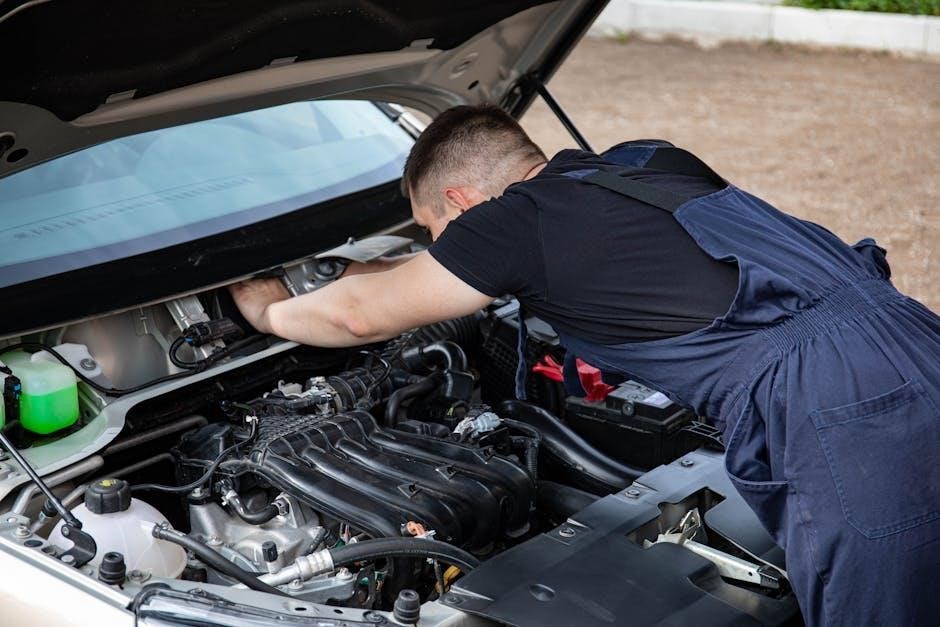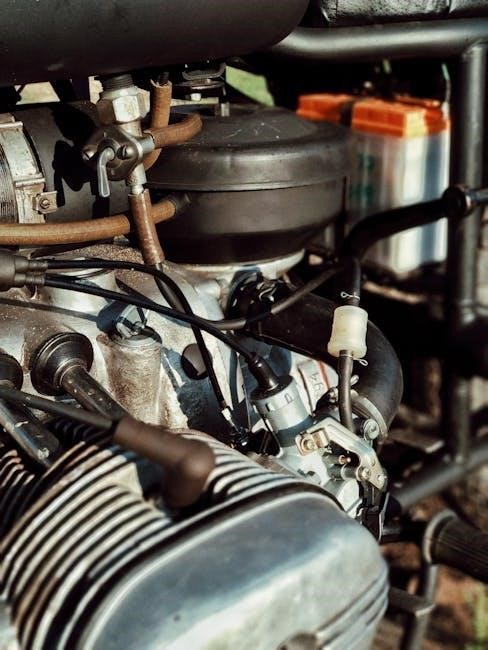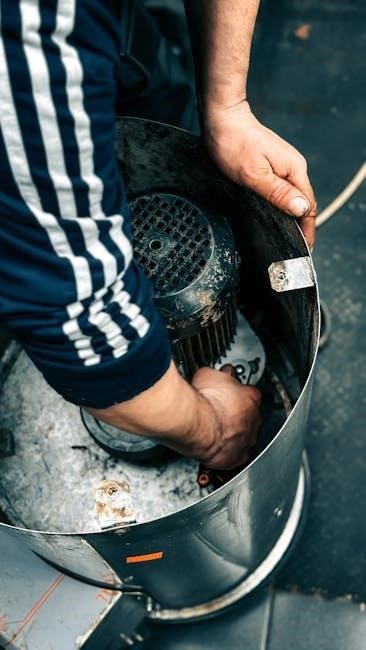cub cadet 243cc engine manual

1․1 Overview of the Cub Cadet 243cc Engine
The Cub Cadet 243cc engine is a reliable power unit designed for outdoor equipment, offering efficient performance and durability․
1․2 Importance of the Engine Manual
The manual provides essential guidance for maintenance, troubleshooting, and safe operation, ensuring optimal performance and longevity of the Cub Cadet 243cc engine․
The Cub Cadet 243cc engine is a powerful and durable powerplant designed for outdoor equipment like lawn mowers and snow throwers․ Engineered for reliability, it delivers consistent performance in various conditions․ With a focus on efficiency, the engine is built to handle demanding tasks while maintaining fuel economy․ Its robust construction ensures longevity, making it a trusted choice for homeowners and professionals alike․ The engine’s specifications, including horsepower and displacement, are designed to meet the needs of heavy-duty applications․ Properly maintained, the Cub Cadet 243cc engine provides years of dependable service, ensuring optimal performance for its intended use․ Regular maintenance is key to its longevity․
The Cub Cadet 243cc engine manual is an essential resource for owners, providing detailed instructions for operation, maintenance, and troubleshooting․ It ensures users understand safety precautions, proper handling, and diagnostic procedures․ Regularly referencing the manual helps maintain engine performance, prevent damage, and extend its lifespan․ The guide also outlines scheduled maintenance tasks, such as oil changes and filter replacements, which are crucial for optimal functionality․ Additionally, the manual serves as a reference for warranty information and technical specifications․ By following the manual’s guidelines, users can maximize the engine’s efficiency and reliability, ensuring it operates at peak performance for years to come․

Key Features
The Cub Cadet 243cc engine is renowned for its robust design, delivering impressive horsepower and displacement․ It offers excellent fuel efficiency, ensuring consistent performance while minimizing fuel consumption․ Built with durable materials, the engine is designed to withstand demanding conditions, making it a reliable choice for various applications․ Its compact size and efficient operation make it ideal for outdoor equipment, providing a balance of power and reliability․ Additionally, the engine features advanced components that contribute to its overall longevity and performance․
2․1 Engine Horsepower and Displacement
The Cub Cadet 243cc engine offers a displacement of 243 cubic centimeters, delivering up to 8․5 horsepower․ This powerful configuration ensures robust performance for outdoor equipment like lawn mowers and snow throwers․ Displacement refers to the total volume of air and fuel the engine can draw in, directly influencing its power output․ With this engine, users can expect efficient operation across various tasks, from mowing dense grass to handling heavy snow conditions․ Its balance of power and efficiency makes it suitable for demanding applications while maintaining fuel economy․ This combination of horsepower and displacement ensures reliable performance, making it a dependable choice for homeowners and professionals alike․
2․2 Fuel Efficiency and Performance
The Cub Cadet 243cc engine is designed for optimal fuel efficiency, ensuring prolonged operation without frequent refueling․ Its performance is enhanced by a balance of power and economy, making it suitable for demanding tasks like mowing and snow removal․ The engine’s fuel efficiency is supported by its 243cc displacement and up to 8․5 horsepower output, providing consistent performance across various applications․ Regular maintenance and the use of the correct fuel type, as outlined in the manual, are crucial for maintaining its efficiency and reliability; This ensures the engine delivers peak performance while minimizing fuel consumption, making it a practical choice for homeowners and professionals․
2․3 Durability and Build Quality
The Cub Cadet 243cc engine is constructed with high-quality materials and robust engineering, ensuring long-term durability and reliability․ Its design incorporates components built to withstand rigorous use in outdoor environments, making it suitable for demanding applications such as lawn mowing and snow removal․ The engine’s build quality is further enhanced by its ability to maintain performance consistency over time, provided regular maintenance is performed as outlined in the manual․ By adhering to the recommended service schedules, users can ensure the engine remains in optimal condition, delivering consistent power and efficiency for years․ This makes the Cub Cadet 243cc engine a dependable choice for both residential and commercial use․

Regular Maintenance
Regular maintenance is crucial for the Cub Cadet 243cc engine to ensure optimal performance and longevity․ Routine tasks include oil changes, filter replacements, and thorough inspections․
3․1 Oil Change and Filter Replacement
Regular oil changes and filter replacements are essential for maintaining the Cub Cadet 243cc engine’s performance and longevity․ It is recommended to change the oil every 25-50 hours of use, depending on operating conditions․ Use a high-quality 10W-30 oil that meets the engine manufacturer’s specifications․ The oil filter should also be replaced at the same time to ensure proper lubrication and prevent contamination․ Always warm up the engine before draining the oil to allow it to flow freely․ Dispose of used oil and filters responsibly․ Refer to the manual for specific instructions and part numbers to ensure compatibility and proper installation․ Regular maintenance helps prevent engine damage and ensures optimal performance․
3․2 Air Filter Cleaning and Replacement
The Cub Cadet 243cc engine requires regular air filter maintenance to ensure proper airflow and combustion efficiency․ The air filter should be inspected and cleaned every 25-50 hours of operation, depending on usage conditions․ Remove the filter and gently tap it to remove loose debris․ For more thorough cleaning, use compressed air or a mild soap solution, but avoid washing if the filter is damaged․ Replace the filter every 100-200 hours or as specified in the manual․ Always use a genuine or compatible replacement filter to maintain performance․ A dirty or clogged air filter can lead to reduced horsepower, poor fuel efficiency, and engine damage․ Regular maintenance ensures optimal engine performance and longevity․
3․3 Spark Plug Inspection and Replacement
Regular inspection and replacement of the spark plug are crucial for maintaining the performance of the Cub Cadet 243cc engine․ The spark plug should be checked every 100-200 hours of operation or as specified in the manual․ Remove the spark plug using a socket wrench and inspect it for fouling, wear, or damage․ Clean the plug with a wire brush if it’s only lightly fouled, but replace it if there are signs of wear․ Use a spark plug of the correct type and gap it according to the manual’s specifications․ Proper installation ensures reliable ignition, smooth engine operation, and optimal fuel efficiency․ Always refer to the manual for torque specifications to avoid damaging the engine․ Regular replacement prevents misfires and maintains engine efficiency․

Operational Guidelines
Proper operation ensures safety and efficiency․ Always follow starting procedures, use throttle and choke correctly, and maintain safe handling practices to prevent accidents and optimize performance․
4․1 Starting and Stopping the Engine
To ensure safe and effective operation, follow proper engine starting and stopping procedures․ Always check the surrounding area for obstacles or bystanders before starting․ Ensure the choke and throttle are in the correct positions․ Prime the engine as specified, then pull the starter cord firmly․ Allow the engine to warm up briefly before use․ When stopping, gradually reduce the throttle and engage the kill switch․ Let the engine cool before restarting․ Refer to the manual for specific instructions tailored to your Cub Cadet 243cc engine model․ Proper starting and stopping techniques help maintain engine longevity and prevent potential hazards․
4․2 Throttle and Choke Operation
Proper operation of the throttle and choke is crucial for efficient engine performance․ The throttle controls engine speed, allowing you to adjust power output for different tasks․ Always start with the choke fully engaged to enrich the fuel mixture for cold starts․ Gradually disengage the choke as the engine warms up․ Avoid leaving the choke on for extended periods, as this can cause excessive fuel consumption and engine damage․ When stopping, ensure the throttle is in the idle position before engaging the kill switch․ Never ride the throttle, as this can lead to inconsistent engine behavior․ Always refer to the manual for specific guidance on throttle and choke operation for your Cub Cadet 243cc engine․
4․3 Safe Handling Practices
Safe handling practices are essential to ensure operator safety and prevent accidents․ Always wear protective gear, including gloves, safety glasses, and sturdy footwear, when operating or maintaining the engine․ Ensure the area is clear of obstacles and keep bystanders, especially children, at a safe distance․ Never handle hot engine components without proper protection․ When lifting or moving the engine, use proper lifting techniques or mechanical aids to avoid injury․ Avoid operating the engine in hazardous conditions, such as near open flames or in areas with poor ventilation․ Always follow the manufacturer’s guidelines for safe handling and operation, as outlined in the Cub Cadet 243cc engine manual․

Troubleshooting Common Issues
Troubleshooting common issues with the Cub Cadet 243cc engine involves identifying symptoms, diagnosing root causes, and applying solutions․ Regular maintenance and manual guidance are key․
5․1 Common Issues and Solutions
The Cub Cadet 243cc engine may experience issues like poor starting, rough running, or low power․ Common causes include faulty spark plugs, clogged air filters, or improper fuel levels․ Solutions involve cleaning or replacing the air filter, checking fuel quality, and inspecting spark plugs for wear․ If the engine overheats, ensure proper cooling system function and clear debris from vents․ For oil leaks, tighten connections and replace worn gaskets․ Regular maintenance, as outlined in the manual, helps prevent these issues․ Always refer to the troubleshooting guide for specific diagnoses and step-by-step repairs to maintain optimal performance and extend engine life․
5․2 Diagnostic Techniques
Diagnosing issues with the Cub Cadet 243cc engine involves systematic troubleshooting to identify root causes․ Start with visual inspections of fuel lines, air filters, and spark plugs for damage or blockages․ Use a compression tester to check for low compression, which may indicate worn piston rings or head gasket issues․ Spark testers can verify if the spark plug is firing properly․ Listen for unusual noises, such as knocking or sputtering, which may signal internal engine problems․ Refer to the manual for specific diagnostic steps and error codes․ Utilize basic tools like multimeters or pressure gauges to test electrical and fuel systems․ Accurate diagnostics ensure effective repairs and prevent further damage․
5․3 Repair and Replacement of Parts
Repairing or replacing parts on the Cub Cadet 243cc engine requires precision to ensure optimal performance․ Always use genuine replacement parts to maintain reliability and safety․ Start by identifying the faulty component through diagnostic checks․ Order the correct part from authorized dealers or online retailers․ Before beginning, disconnect the spark plug and ensure the engine is cool․ Follow the manual’s step-by-step instructions for disassembly and reassembly․ Tighten bolts and fasteners to the specified torque values to avoid damage․ After replacement, test the engine under load to confirm proper function․ If unsure, consult a professional mechanic to prevent further issues․ Regular replacement of worn parts extends engine lifespan and maintains efficiency․

Performance Optimization
Optimize the Cub Cadet 243cc engine’s performance by ensuring proper tuning, using the correct fuel type, and monitoring key metrics to maintain peak efficiency and power output․
6․1 Tuning the Engine
Tuning the Cub Cadet 243cc engine involves adjusting components like the carburetor, ignition timing, and valve clearance to ensure optimal performance․ Regular tuning helps maintain engine efficiency, power output, and fuel economy․ Start by checking the air-fuel mixture to prevent lean or rich conditions, which can damage the engine․ Use a tachometer to set the idle speed within the recommended range․ Adjust the valve clearance as specified in the manual to ensure proper combustion․ Always use the tools and procedures outlined in the Cub Cadet manual to avoid errors or warranty issues․ Proper tuning not only enhances engine longevity but also ensures smooth operation under varying workloads․
6․2 Using the Correct Fuel Type
Using the correct fuel type is crucial for optimal performance and longevity of the Cub Cadet 243cc engine․ The manual specifies that regular unleaded gasoline with an octane rating of 87 is recommended․ Using lower or higher octane fuel can lead to engine knocking, reduced efficiency, or potential damage․ Avoid using ethanol blends with more than 10% ethanol, as they can cause corrosion and clogging in the fuel system․ Old or contaminated fuel should also be avoided, as it can cause starting issues or poor engine performance․ Always use fresh fuel and store it properly to maintain engine health and reliability․
6․3 Monitoring Performance Metrics
Monitoring performance metrics is essential to ensure the Cub Cadet 243cc engine operates efficiently and reliably․ Key metrics include engine RPM, which should be maintained within the recommended range of 2,800 to 3,600 RPM for optimal performance․ Over-revving or under-revving can lead to poor efficiency or engine strain․ Additionally, horsepower output should align with the engine’s rated capacity, typically around 11-12 HP for this model․ Regularly checking these metrics helps identify potential issues early, such as uneven throttle response or reduced power․ Proper monitoring ensures the engine runs smoothly and maintains its longevity under various operating conditions․
Safety Precautions
Always wear protective gear, ensure proper ventilation, and avoid hazardous conditions․ Follow emergency shutdown procedures and maintain a safe distance from moving parts to prevent accidents․
7․1 Protective Gear and Clothing
Wearing proper protective gear is crucial when operating or maintaining the Cub Cadet 243cc engine․ Always use gloves to prevent cuts and abrasions, and wear safety glasses or a face shield to protect your eyes from debris․ Sturdy, closed-toe footwear is essential to avoid foot injuries․ Additionally, wear long sleeves and pants to minimize skin exposure․ Avoid loose clothing that could get caught in moving parts․ A dust mask is recommended when handling dusty components․ Ensure all protective gear meets safety standards and is in good condition․ Proper attire helps prevent accidents and ensures safe operation of the engine and connected equipment․
7․2 Operating in Hazardous Conditions
When operating the Cub Cadet 243cc engine in hazardous conditions, exercise extreme caution․ Avoid running the engine in areas with extreme temperatures, flammable materials, or poor ventilation․ Never operate near open flames or sparks․ In wet conditions, ensure the engine and surrounding area are clear of water to prevent electrical hazards․ Avoid steep slopes or unstable terrain to maintain control and prevent tipping․ Always check for loose debris or obstacles that could interfere with operation․ Be aware of carbon monoxide risks in enclosed spaces․ If conditions are unsafe, stop the engine and wait for improvement․ Prioritize safety to prevent accidents and damage․
7․3 Emergency Shutdown Procedures
In case of an emergency, shut down the Cub Cadet 243cc engine immediately to prevent damage or injury․ Locate the ignition switch, typically found on the control panel, and turn it to the “OFF” position․ If equipped, engage the emergency stop or kill switch to halt operation instantly․ For additional safety, remove the spark plug wire to ensure the engine cannot restart․ Allow the engine to cool before inspecting or restarting․ Never restart the engine without identifying and resolving the cause of the emergency․ Always prioritize safety and avoid operating the engine in unstable or dangerous conditions․ Follow these steps to ensure a secure shutdown․

User Manual Highlights
The Cub Cadet 243cc engine manual provides essential guidance, ensuring ease of use and maintenance․ It highlights key sections for troubleshooting, safety, and performance optimization, making it indispensable for owners․
8․1 Navigating the Manual
Navigating the Cub Cadet 243cc engine manual is straightforward, with clear sections and an index for quick access․ The manual is organized into logical chapters, such as maintenance, troubleshooting, and operational guidelines․ Users can easily locate specific topics using the table of contents or by searching for keywords․ For first-time users, the manual often includes a quick-start guide to familiarize them with key features and procedures․ Visual aids like diagrams and charts enhance understanding, while numbered steps provide clear instructions․ This structure ensures users can efficiently find the information they need without unnecessary complexity․
8․2 Understanding Technical Specifications
Understanding the technical specifications of the Cub Cadet 243cc engine manual is crucial for optimal performance and maintenance․ The manual provides detailed information about engine horsepower, torque, displacement, and fuel type․ These specs help users identify the engine’s capabilities and limitations․ Key metrics like oil capacity, spark plug type, and ignition timing are also included․ Familiarizing yourself with these details ensures proper operation and maintenance․ The manual may also list compatible parts and tools, aiding in repairs or upgrades․ By reviewing these specifications, users can better understand their engine’s requirements and make informed decisions to maximize its efficiency and longevity․
8․3 Following Maintenance Schedules
Following the maintenance schedules outlined in the Cub Cadet 243cc engine manual is essential for ensuring optimal performance and extending the engine’s lifespan․ Regular tasks such as oil changes, air filter cleaning, and spark plug inspections are detailed with specific timeframes or usage milestones․ Neglecting these schedules can lead to reduced efficiency, increased emissions, or even engine damage․ The manual provides clear guidelines on when and how to perform each maintenance task, ensuring everything is done correctly․ Adhering to these schedules helps maintain warranty validity and prevents costly repairs․ By staying proactive with maintenance, users can enjoy reliable operation and consistent power delivery from their Cub Cadet engine․

Downloading the Manual
The Cub Cadet 243cc engine manual can be downloaded from official sources, ensuring easy digital access to maintenance and operational guides with detailed information for optimal performance and troubleshooting․
9․1 Sources for Official Manuals
The Cub Cadet 243cc engine manual is available for download from the official Cub Cadet website, authorized dealers, or trusted third-party platforms like ManualsLib or ManualsOnline․ Ensure authenticity by verifying the source’s credibility to avoid counterfeit or outdated versions․ Official sources provide accurate and comprehensive guides tailored to your engine model, ensuring reliability and safety․ Always cross-check the manual’s serial number or engine model with the download source to confirm compatibility․ Additionally, Cub Cadet customer support can direct you to verified download links if needed․ Avoid unofficial sites to prevent potential security risks or incorrect information․
9․2 PDF Format and Compatibility
The Cub Cadet 243cc engine manual is typically available in PDF format, ensuring universal compatibility across devices․ PDFs maintain consistent formatting and readability on desktops, tablets, and smartphones․ To view the manual, a PDF reader like Adobe Acrobat or equivalent software is required․ Compatibility extends across operating systems, including Windows, macOS, iOS, and Android․ Digital storage options, such as cloud services or email attachments, make it easy to access the manual anytime․ Ensure your device has the latest PDF viewer updates for optimal performance․ This format allows users to zoom, search, and print specific sections effortlessly, enhancing usability for maintenance and troubleshooting tasks․
9․3 Language and Regional Variations
The Cub Cadet 243cc engine manual is primarily available in English, catering to its main market․ However, regional variations may include translations into Spanish, French, or other languages to accommodate global users․ Manuals are tailored to meet local regulations, emissions standards, and operational practices․ For instance, manuals for North America may differ slightly from those in Europe or Australia due to regional compliance requirements․ Users should ensure they download the version specific to their country or region for accurate information․ Additionally, terminology and safety guidelines may vary to align with local laws and cultural preferences, ensuring clarity and relevance for diverse audiences․

Compression and File Handling
Compression reduces file size for easier storage and sharing․ Use tools like Adobe Acrobat or online compressors to maintain quality while minimizing space․ Ensure compatibility across devices․
10․1 Reducing PDF File Size
Reducing the PDF file size of the Cub Cadet 243cc engine manual ensures easier sharing and storage․ Use tools like Adobe Acrobat to compress images and remove unnecessary embedded fonts․ Downsampling images and converting to grayscale can significantly lower the file size without losing clarity․ Additionally, remove any unnecessary pages or annotations to optimize the document․ Free online tools like Smallpdf or ILovePDF also offer efficient compression options․ Always ensure the compressed file remains legible and retains all critical information․ This makes the manual more accessible for users with limited storage or slower internet connections․ Regularly updating and compressing the manual ensures it remains user-friendly and efficient․
10․2 Maintaining Quality During Compression
Maintaining quality during PDF compression for the Cub Cadet 243cc engine manual is crucial to ensure readability and usability․ Use tools with quality-preserving settings, like Adobe Acrobat, which offers options to balance file size and clarity․ Select higher quality compression profiles to retain image and text sharpness․ Avoid over-compression, as it may render diagrams illegible․ Review the compressed file to ensure all technical details remain clear․ Consider using lossless compression for critical images․ Prioritize retaining the manual’s instructional value, as compromised quality could hinder understanding and proper engine maintenance․ Always test the final document to confirm its effectiveness․
10․3 Tools and Software for Compression
Various tools and software are available to compress the Cub Cadet 243cc engine manual effectively․ Adobe Acrobat offers advanced compression features, ensuring reduced file sizes while maintaining clarity․ Online platforms like Smallpdf and ILovePDF provide user-friendly interfaces for quick compression․ For open-source solutions, tools like GIMP or Ghostscript can be utilized․ Additionally, built-in operating system features, such as macOS Preview or Windows’ built-in PDF optimizers, offer efficient compression options․ These tools help reduce file size without compromising readability, ensuring the manual remains accessible and functional for users needing detailed engine information․ Always choose tools that prioritize quality retention during compression․

Environmental Considerations
The Cub Cadet 243cc engine manual emphasizes eco-friendly practices, such as proper emissions control and waste disposal․ Using eco-conscious fuels and recycling materials helps reduce environmental impact․
11․1 Emissions and Eco-Friendliness
The Cub Cadet 243cc engine is designed with eco-friendly features to minimize environmental impact․ It incorporates advanced emission control technologies, such as catalytic converters, to reduce harmful pollutants․ The engine meets strict EPA and CARB standards, ensuring lower emissions and eco-conscious performance․ Regular maintenance, as outlined in the manual, helps maintain optimal emission levels․ Using the recommended fuel types and adhering to proper operating practices further reduces environmental footprint․ The manual also emphasizes the importance of proper disposal of hazardous materials to protect ecosystems․ By following these guidelines, users can ensure the engine runs efficiently while promoting sustainability and reducing its ecological impact․ Proper care extends the engine’s life and benefits the environment․
11․2 Proper Disposal of Waste Materials
Proper disposal of waste materials from the Cub Cadet 243cc engine is crucial for environmental protection․ The manual emphasizes eco-friendly practices, such as recycling used oil, filters, and batteries․ Users are advised to take these materials to authorized recycling centers or service providers․ Never dispose of hazardous waste in regular trash, as it can contaminate soil and water․ Additionally, the manual recommends wearing protective gear when handling waste to prevent exposure to harmful substances․ Always follow local regulations and guidelines for waste disposal to ensure compliance and minimize environmental impact․ Proper disposal practices help preserve the environment and promote sustainability․